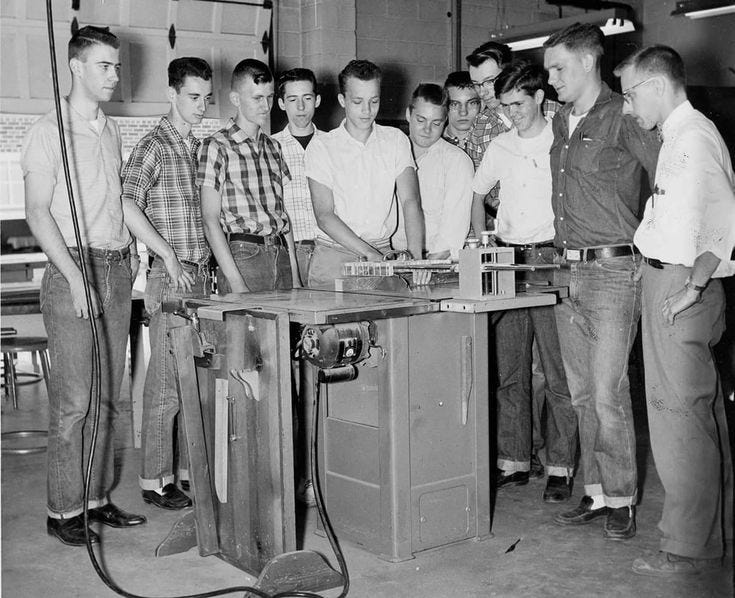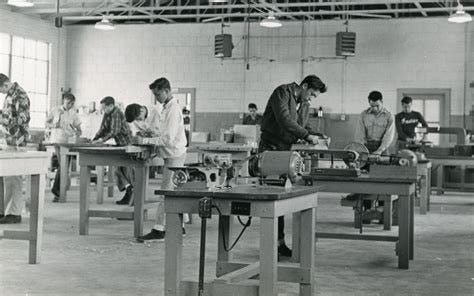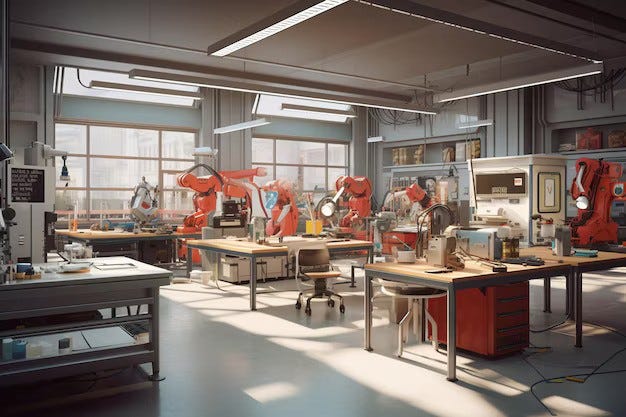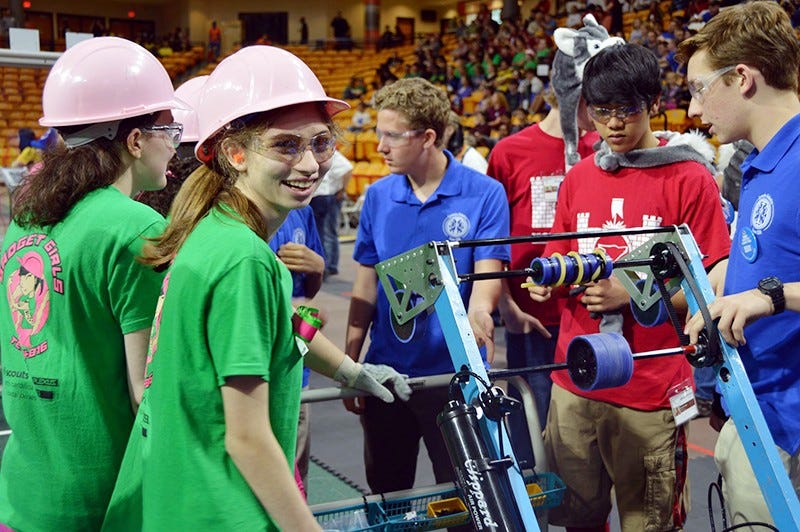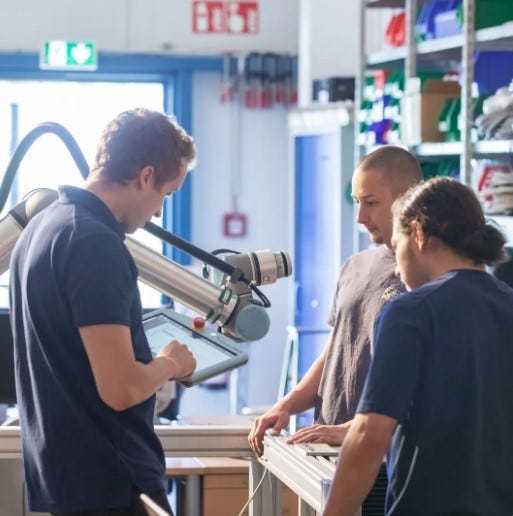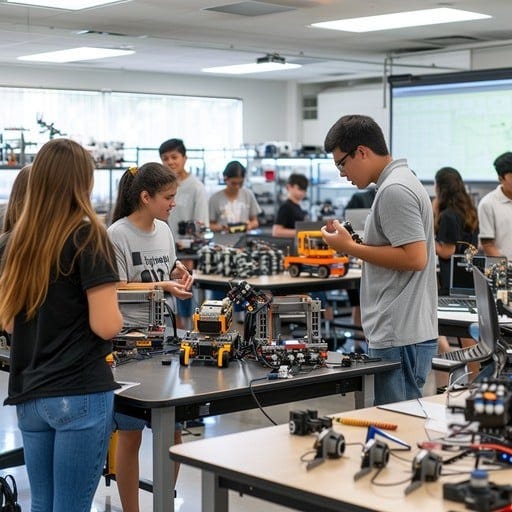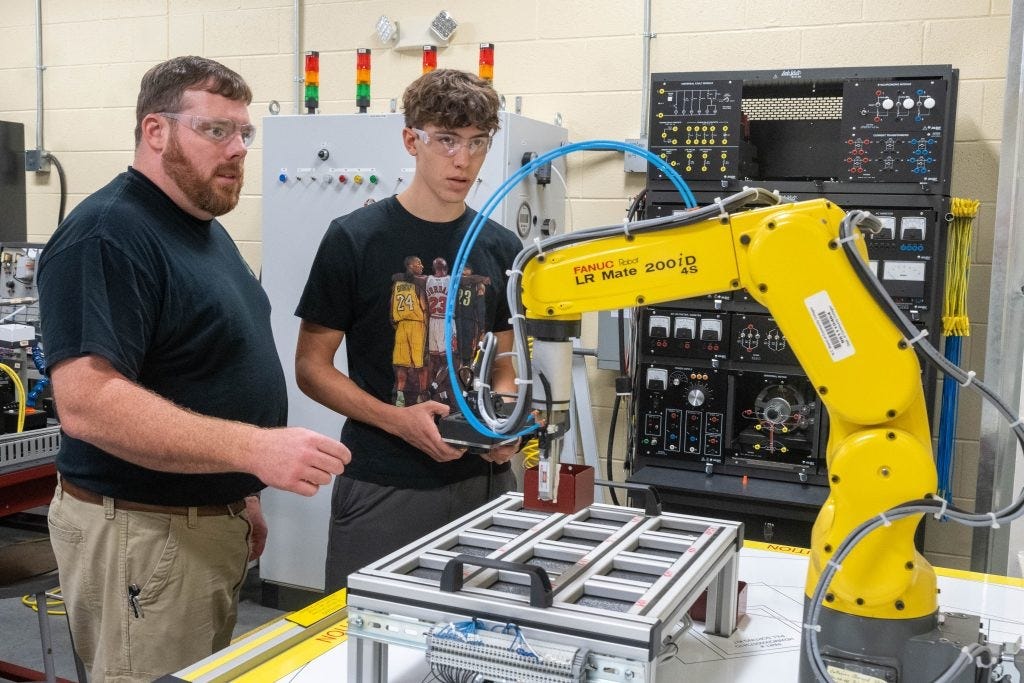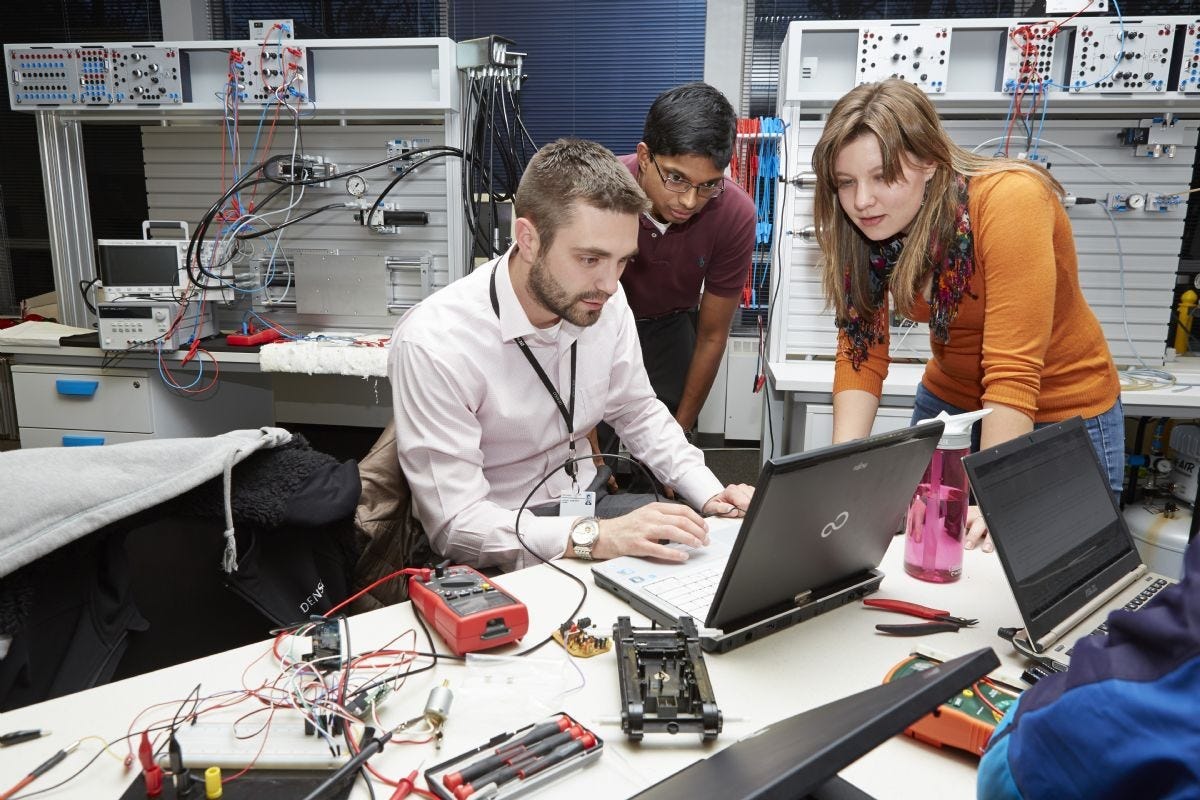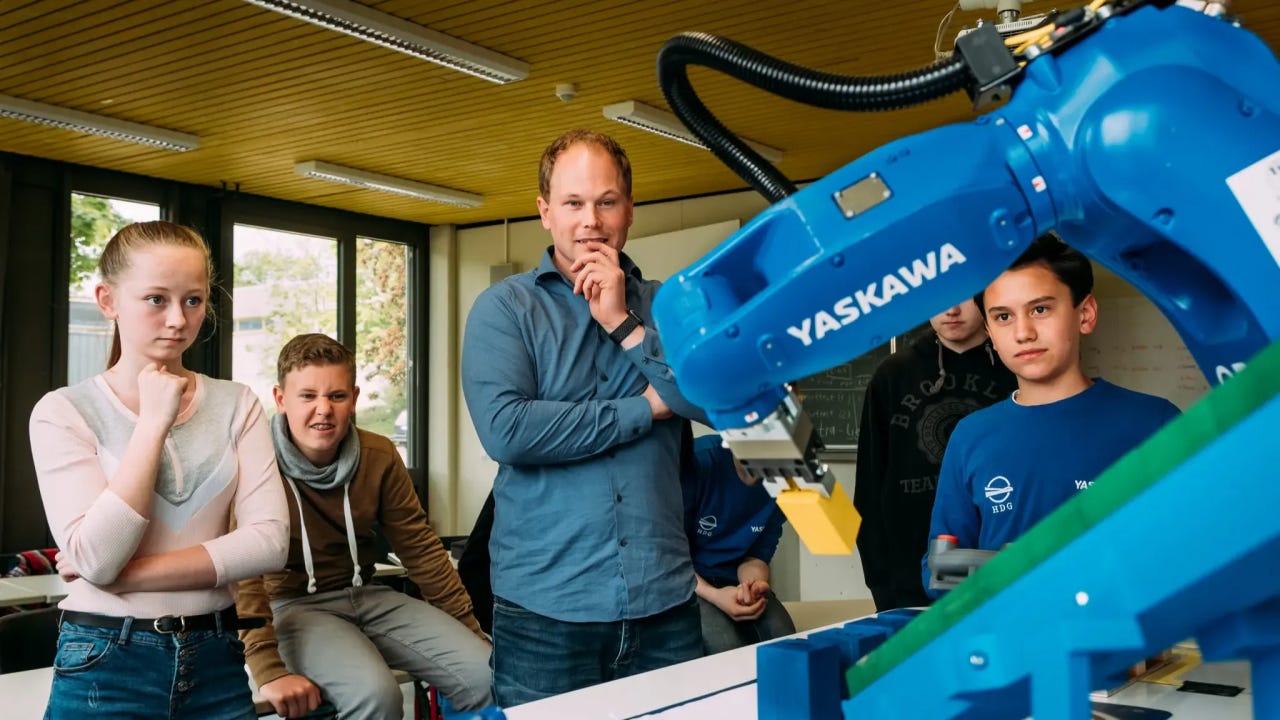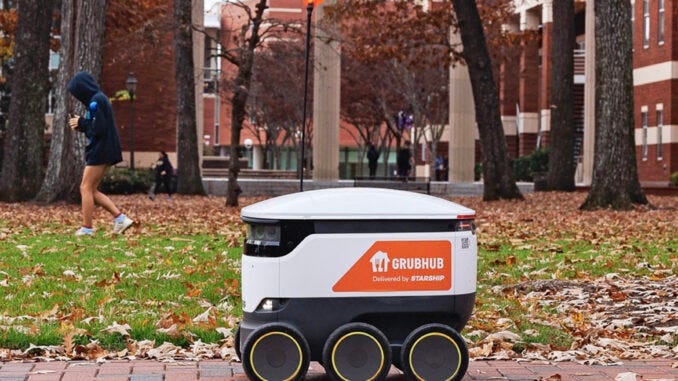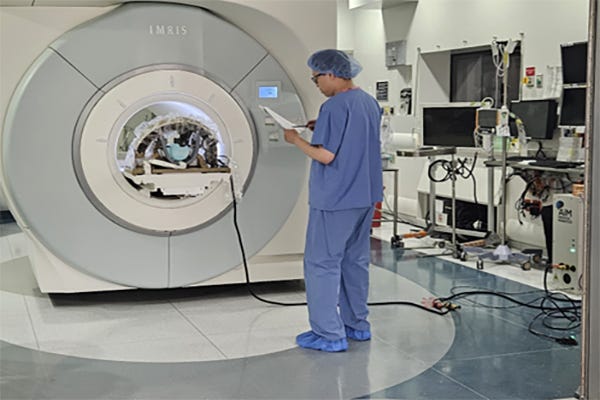Wiring the Future: Inside America’s New Robotics Shop Class
From FIRST Robotics to factory floors, a new generation is learning to think in code and metal.
“Tell me and I forget. Teach me and I remember. Involve me and I learn.” — Benjamin Franklin
You can still smell it if you close your eyes: sawdust, hot solder, the faint tang of cutting oil. For most of the 20th century, American high schools had rooms where kids learned how to wire a switch, square a board, rebuild a carburetor. Then, almost quietly, those rooms vanished—replaced by test-prep labs, college-readiness seminars, and, later, rows of Chromebooks. Now, as robots slip into warehouses, hospitals, construction sites, even airports, we’re rediscovering that the future still runs on people who can read a wiring diagram and a risk assessment—who can think in both code and metal.
This is the story of how we lost that capacity, why it matters now, and how a new “robotics shop class” could change the country’s talent pipeline.
From “A Nation at Risk” to a nation low on wrenches
The inflection point is familiar: in 1983, A Nation at Risk warned that American schools faced “a rising tide of mediocrity,” catalyzing an era of standards-driven reform that prioritized academic coursework and testing. Career and technical education—shop—was deemed non-core and steadily sidelined.
Two decades later, the No Child Left Behind Act tied school accountability even more tightly to reading and math scores. Under pressure, districts expanded the number of tested subjects and often trimmed elective, hands-on classes to make room. Research examining NCLB’s ripple effects noted how CTE courses—primarily electives—were more challenging to protect in this environment.
The cultural baggage didn’t help. For years, “voc ed” tracked some students—too often low-income and students of color—away from college. That stigma lingers even as modern CTE evolves. National reporting and commentary from the 2010s captured both the shrinkage of traditional shop programs and the need to rebuild them for today’s economy.
Meanwhile, the world went robotic
While schools chased test scores, industry retooled. Robotics became normal—not sci-fi. Manufacturers adopted collaborative arms, AGVs and AMRs rolled through logistics hubs, hospitals added autonomous cleaning fleets, and construction began experimenting with layout, welding, and finishing robots. Employers say their main constraint isn’t ideas—it’s people.
Multiple studies project millions of advanced manufacturing roles could remain unfilled without a broader talent pipeline. A widely cited Deloitte–Manufacturing Institute analysis forecasts up to 2.1 million unfilled U.S. manufacturing jobs by 2030 if trends persist; more recent work emphasizes that the gap is both skills and applicants.
These aren’t all PhD roles. Many are technician jobs that blend mechanical and electrical troubleshooting, PLCs, and safety protocols—exactly the hybrid literacy that shop once cultivated. The Bureau of Labor Statistics describes electro-mechanical/mechatronics technologists and technicians as the people who install, test, and maintain robotic and electromechanical systems—typically trained via community college or postsecondary certificates.
The “new shop class” already exists—just not everywhere
If you want to see what a modern shop can be, walk into a FIRST Robotics regional or a high school makerspace. FIRST reports more than 785,000 youth participants globally in the 2023–24 season, learning to design, wire, code, and iterate under deadline—an authentic apprenticeship in systems thinking.
Alongside competitions, the maker movement put fabrication tools in students’ hands. The Fab Lab network that grew from MIT now counts thousands of spaces worldwide; the point isn’t gadgets, it’s mindset—students who learn by building real things with real constraints.
And industry is stepping in. FANUC’s Certified Education Training (CERT) program says it now partners with 1,600+ schools across the Americas to deliver robot and CNC curricula aligned to factory equipment. Siemens’ Mechatronic Systems Certification Program gives high schools and colleges a stackable path from “assistant” up through advanced mechatronics credentials.
Even employers are rebuilding shop at scale. Amazon’s Mechatronics & Robotics Apprenticeship combines a concentrated technical boot camp with a year of paid on-the-job learning for Reliability & Maintenance Engineering roles—an explicit “learn-and-earn” onramp into robotics maintenance.
States and universities are following suit. In August 2025, the University of Maine opened the B.O.T. Loft, a 3,600-square-foot training space inside its Advanced Manufacturing Center, with equipment from Doosan, UR, ABB, and FANUC. Doosan simultaneously launched an Authorized Training Center there—expanding a network that offers factory-aligned curricula from K-12 camps to professional certifications.
And because learners and employers need a trusted map, the ARM Institute built RoboticsCareer.org, a national directory (and endorsement system) to match people with vetted technician training aligned to industry-defined skills. That work is part of Manufacturing USA, funded by the Department of Defense and Labor—evidence that workforce is now seen as infrastructure.
The paradox: Robotics needs coders and craftspeople
One reason “shop” faded is that it was often framed as the opposite of academics. Robotics blows up that binary. A student troubleshooting a cobot cell must interpret torque curves and safety categories, crimp connectors to spec, read a datasheet, and write a calibration script. That’s physics, ELA (technical documentation), statistics, and CS—plus the literal feel of a ratchet.
Empirically, CTE participation correlates with better near-term labor market outcomes; modern studies also show that when students attend high-quality technical programs, graduation and earnings gains are significant—especially where home schools have limited offerings.
And CTE is shedding its stigma. Some districts report high-achieving students flocking to technically rigorous programs that come with industry credentials and dual credit, reframing hands-on coursework as a fast track to opportunity.
The equity catch
The new shop class is unevenly distributed. Wealthier districts and magnet programs are more likely to boast robotics labs, while under-resourced schools still struggle to offer even basic CTE. Teacher labor markets make it harder: districts report CTE teacher positions are harder to fill than academic roles, and CTE instructors with in-demand licenses can often earn ~20% more in the industry.
Federal policy has started to move. In 2018, Congress reauthorized CTE funding through Perkins V, providing roughly $1.4 billion annually and more flexibility for states to align programs with employer needs. But dollars alone won’t fix uneven access to gear, mentors, and work-based learning.
The solution has to be systemic: equipment, plus teacher pipelines, plus industry partnerships, plus portable credentials.
What a modern “robotics shop class” should look like
1) Start with safety and systems. Treat every lab like a small factory. Teach lockout/tagout, risk assessment, and ISO/ANSI robot safety concepts alongside wiring and kinematics. A student who learns to document hazards, set E-stops, and design a safe layout becomes instantly useful—and safer. (BLS highlights that these roles involve exposure to equipment hazards mitigated by training and procedures.)
2) Build stackable credentials that actually count. Adopt industry-recognized certifications (e.g., FANUC CERT, Siemens SMSCP) that map to local demand, so a 17-year-old can graduate with signals employers trust—and continue stacking in community college or an apprenticeship.
3) Make work-based learning the default. Treat internships, co-ops, pre-apprenticeships, and apprenticeships as integral to the curriculum. Programs like Amazon’s MRA are instructive: classroom + line-side practice + job placement. Regional employers can replicate this with local colleges and workforce boards.
4) Connect students to the national map. Use platforms like RoboticsCareer.org to help learners (and counselors) find local training that aligns with recognized career pathways—and to help employers find talent.
5) Fund teacher pipelines like critical infrastructure. States should create “earn-and-learn” fellowships to lure industry veterans into CTE teaching, with residency models and retention bonuses. Brookings’ analysis of CTE teacher attrition underscores the need for targeted policies.
6) Measure what matters. Hold programs accountable for placements, wage gains, and safety outcomes—not just enrollment. NCES’ CTE indicators give a baseline; states can augment with industry-verified assessments and longitudinal tracking.
Why is this urgent
The U.S. is pouring public and private capital into semiconductor fabs, EV plants, shipyards, depots, and defense manufacturing. The labor market data are blunt: demand is rising faster than supply, and the shortfall is increasingly in technician roles that require hands and mind. If we don’t expand the technician pipeline, much taxpayer-funded equipment will sit underutilized.
There’s also a social truth that doesn’t fit neatly into spreadsheets: students remember what they build. A teen who spends a semester bringing a stuck axis back to life, or shaving five minutes off a cell’s cycle time, develops a deep sense of agency. That is the heart of career-connected learning—and the antidote to the disengagement that has haunted post-pandemic schooling.
And for those worried that “shop” will trap students below a four-year ceiling: today’s pathways are permeable. One route starts with a high-school mechatronics credential, leads to an associate degree and an apprenticeship, and later stacks into a B.S. in engineering technology—with employers helping pay the way. Robotics isn’t a detour from higher education; it’s a bridge into it.
A glimpse of what’s possible
Consider a district that pairs a high school robotics lab with a community college mechatronics program and local employers. Students rotate through FIRST season in the fall, earn FANUC or Siemens Level 1 in the spring, and spend the summer paid—shadowing maintenance techs in a warehouse, a hospital’s facilities team, or an advanced manufacturing cell. Seniors choose: direct hire at 18, a pre-apprenticeship, or dual enrollment toward an associate. Counselors use RoboticsCareer.org to keep the ladder visible; teachers get release time to update their own certifications. The lab looks like a small integrator: CAD, metrology, pneumatics, a vision kit, a cobot, a mobile base, safety fencing—and a clear hazard plan on the door.
States are inching this way. School systems are investing in advanced CTE facilities, and universities are launching training hubs tied to defense and industry demand—like the University of Maine’s new B.O.T. Loft, which explicitly exists to help companies trial automation and train the humans who will run it. That’s shop class as economic strategy.
Bring back shop—on purpose
We don’t need nostalgia. We need ambition: to treat hands-on technical education as a first-class route to prosperity and national capacity. The blueprint is on the table:
Keep the rigor of academic standards and restore the rigor of the lab.
Fund spaces, tools, and—most importantly—teachers.
Tie programs to real credentials, real employers, and real safety.
Make sure every student, not just the already advantaged, can reach the onramps.
If A Nation at Risk helped push us into an era of narrow metrics, Perkins V and employer-backed models can help bring balance—resourcing CTE to meet what the economy actually needs.
The choice is less about robots than about respect for the people who will build, integrate, fix, and improve them. The smell of sawdust might be gone, replaced by the hum of a harmonic drive. But the core of shop class—the alchemy of learning by making—still changes lives. Let’s bring it back, tuned for a robotic age.
Robot News Of The Week
Starship Technologies has raised $50 million to expand its autonomous delivery network across the U.S., aiming to grow its robot fleet from 2,700 to 12,000 by 2027. Already one of the most advanced players in the sector, Starship’s robots have completed 8 million deliveries and logged 10 million miles, operating on 55+ campuses and in several European cities through partnerships with Grubhub and Wolt. The company now completes about 150,000 crossings daily, leveraging AI and sensor data to continuously optimize routes.
This latest round—led by Plural, Karma.vc, Latitude, Coefficient Capital, SmartCap, and Skaala—brings Starship’s total funding to over $280 million, signaling strong investor confidence in its technology and business model.
Starship’s expansion comes amid rising competition. Serve Robotics, backed by DoorDash, has completed over 100,000 deliveries in U.S. cities, while Coco Robotics and Uber Eats are advancing their own automated fleets. For restaurants, delivery robots promise lower labor costs and faster service, but challenges remain—uneven city regulations, weather, battery life, and infrastructure not built for robots.
Economically, the model depends on high utilization and reliable performance. Still, with vast real-world data and operational experience, Starship believes it can make robot delivery an everyday reality by 2026–2027, reshaping how meals and groceries move through cities—and how restaurants balance human and robotic delivery options.
HavocAI obtains $85M to scale autonomous marine systems
HavocAI Inc., a Providence, Rhode Island–based startup, has raised $85 million to scale its autonomous marine platforms, bringing its total funding to nearly $100 million just 18 months after launch. The round included B Capital, In-Q-Tel, Lockheed Martin, Hanwha, Taiwania, Vanderbilt University, and others, marking a major valuation jump and growing international recognition of HavocAI’s role in maritime autonomy.
Founded in 2024, HavocAI has already delivered over 30 operational systems to the U.S. military and demonstrated collaborative “swarming” autonomy across Navy and Army programs. The company takes a software-first approach, aiming to enable “heterogeneous, self-organizing fleets” that can be managed by a single operator. Its vessels include the 14-ft Rampage, 38-ft Seahound, 42-ft Kiakoa, and 100-ft Atlas, with partnerships spanning Lockheed Martin, PacMar, Metal Shark, Ilmor, and Tocaro Blue.
The new capital will support expansion into new vessel types, increased manufacturing to meet U.S. military demand for thousands of autonomous boats, and operations with allied forces, especially in the Indo-Pacific. Investors praised HavocAI’s ability to deliver working, scalable systems, calling it a clear market leader in a field critical to maritime security and deterrence.
AiM Medical Robotics secures $8.1 million Series A funding
Massachusetts-based AiM Medical Robotics has closed an $8.1 million Series A round led by IQ Capital and 1540 Ventures, bringing its total funding to over $11.3 million. The company develops MRI-compatible surgical robots that enable neurosurgeons to operate directly inside an MRI scanner, improving precision and eliminating the need to move patients between rooms.
AiM’s system combines real-time MRI imaging with robotic guidance to ensure accurate placement of neurostimulation leads for Parkinson’s disease and other cranial procedures such as tumor biopsy, ablation, and targeted drug delivery. CEO Dr. Gregory Fischer said the company is preparing for first patient enrollment and aims to demonstrate broad clinical impact across neurosurgery.
The technology promises faster, safer, and more consistent outcomes while reducing patient risk and healthcare costs, positioning AiM as a key player in the next generation of image-guided robotic surgery.
Robot Research Of The Week
Soft skin allows vine robots to navigate complex, fragile environments
Researchers at the University of California San Diego have created a soft robotic skin that allows vine-like robots—just a few millimeters wide—to navigate tight, delicate spaces such as human arteries and jet engine interiors.
The skin uses liquid crystal elastomer actuators that bend when heated, combined with internal pressure control to steer the robot. This dual system gives precise movement at small scales where traditional motors or tendons fail.
In tests, a 3–7 mm-wide, 25 cm-long robot equipped with the skin made multiple sharp turns and squeezed through gaps half its size, demonstrating agility and strength. The technology, described in Science Advances, could one day power minimally invasive medical devices, inspection robots, or wearable haptics.
Future work will focus on making the system smaller, remote-controlled, or autonomous, expanding its potential for delicate and constrained environments.
This Eighth Grader Is Shaping the Future of Wearable Robotics
An eighth grader from northwest Atlanta is helping researchers at Georgia Tech shape the future of wearable robotics — one step at a time.
Casey Neel, who was diagnosed with cerebral palsy at birth, has spent the past four years collaborating with engineers in Georgia Tech’s EPIC Lab (Exoskeleton and Prosthetic Intelligent Controls), providing crucial feedback on experimental robotic exoskeletons designed to improve mobility and independence for people with movement disorders.
Researchers say Casey’s perspective has been invaluable. Unlike adult test subjects or short-term clinical studies, his long-term participation offers a rare window into how assistive robotics can evolve alongside a growing body — revealing how comfort, adaptability, and usability change over time. His insights have helped the team refine sensor placement, improve control algorithms, and make the devices more intuitive for everyday use.
For Casey, the project is more than research — it’s empowerment. “I get to help make something that could help other kids walk better,” he told local media. The Georgia Tech team, led by Dr. Aaron Young, hopes that partnerships like this one will accelerate development of personalized exoskeletons that adjust dynamically to users’ needs, paving the way for a new generation of wearable robots that restore motion, confidence, and independence.
Robot Workforce Story Of The Week
Amazon and Carnegie Mellon University Launch Strategic AI Innovation Hub
Amazon and Carnegie Mellon University (CMU) have announced the CMU–Amazon AI Innovation Hub, a new partnership aimed at accelerating research in generative AI, robotics, natural language processing, and cloud computing.
Amazon will provide major funding for joint research, Ph.D. fellowships, and community programs to drive breakthroughs in responsible AI and next-generation systems.
“The convergence of agentic AI, robotics, and language technologies represents an unprecedented opportunity to reshape how we live and work,” said Swami Sivasubramanian, VP of Agentic AI at AWS.
CMU’s Theresa Mayer, VP for Research, called the partnership a model for industry–academic collaboration:
“By bringing together our faculty and students with Amazon scientists, we’re creating new pathways for innovation that benefit society and expand the frontiers of knowledge.”
The Hub will fund joint projects, doctoral fellowships, and symposia—including its first research event on October 28 at CMU’s Pittsburgh campus.
Robot Video Of The Week
Caltech’s CAST and TII just showed something brilliant: a Unitree G1 humanoid carrying M4 — a backpack robot that flies, lands, drives, then transitions modes to overcome obstacles. In a campus demo the humanoid walked, deployed M4 from its back, M4 drove around a pond, then flew back over it to reach an “emergency” — all coordinated as one system.
Why this matters:
• Multimodal locomotion (walk + fly + drive) expands where robots can operate.
• Tight hardware + control co-design (Saluki controller, lidar/cameras, model-based learning) makes autonomy safer and more adaptable.
• Collaboration across CAST, TII, Northeastern, and Caltech labs shows the power of cross-discipline teams in solving real-world robotics problems.
Biggest takeaway: combining locomotion modalities gives robots the complementary strengths of each — speed, endurance, and terrain dexterity — while shrinking their weaknesses. Exciting step toward more useful, resilient, real-world robot teams.
Upcoming Robot Events
Oct. 19-25 IEEE IROS (Hangzhou, China)
Oct. 27-29 ROSCon (Singapore)
Oct. 29-31 Intl. Symposium on Safety, Security, and Rescue Robotics (Galway, Ireland)
Nov. 3-5 Intl. Robot Safety Conference (Houston, TX)
Dec. 1-4 Intl. Conference on Space Robotics (Sendai, Japan)
Dec. 11-12 Humanoid Summit (Silicon Valley TBA)
Jan. 5-6 UK Robot Manipulation Workshop (Edinburgh, Scotland)
Jan. 19-21 A3 Business Forum (Orlando, FL)
Mar. 16-19 Intl. Conference on Human-Robot Interaction (Edinburgh, Scotland)
Mar. 23-27 European Robotics Forum (Stavanger, Norway)
Mar. 29-Apr. 1 IEEE Haptics Symposium (Reno, NV)
May 27-28 Robotics Summit & Expo (Boston, MA)
June 1-5 IEEE ICRA (Vienna, Austria)
June 22-25 Automate (Chicago, IL)


